7.2 /10 1 Votes7.2
78% Rotten Tomatoes Cinematography Loyal Griggs Director Mark Robson Box office 4.7 million USD (US) | 6.8/10 IMDb Directed by Mark Robson Initial release December 1954 Story by James A. Michener Music director Lyn Murray | |||||||||||||||||||||||||||||||||
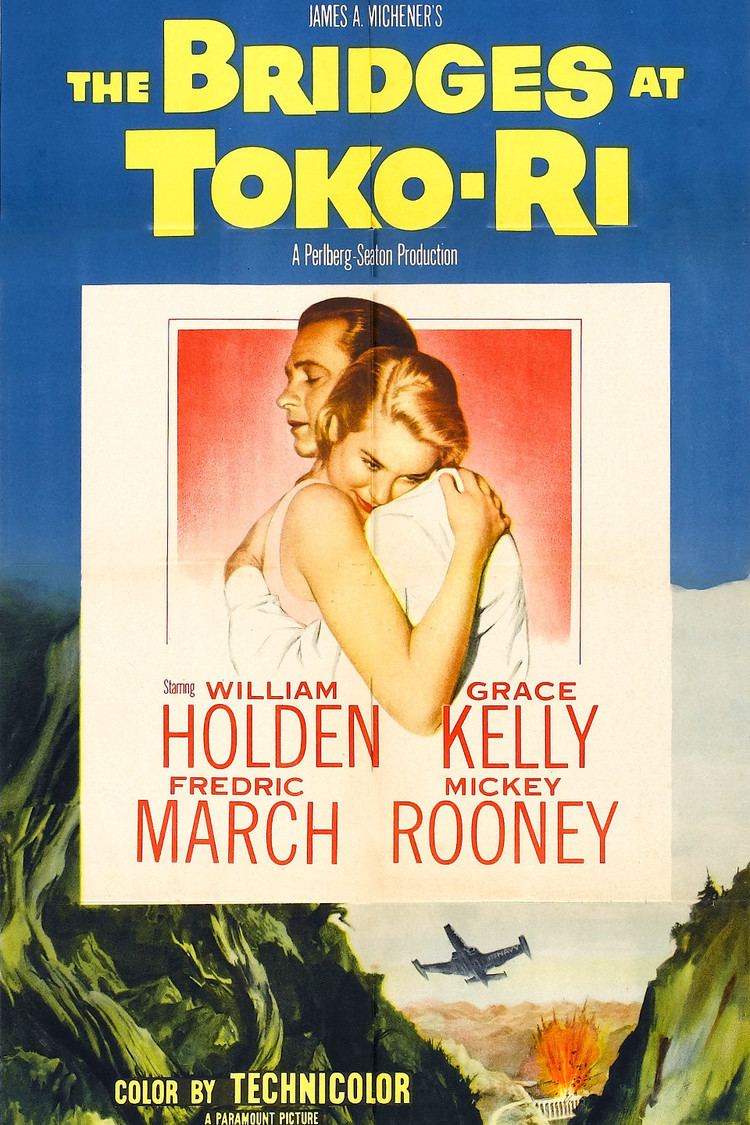 | ||||||||||||||||||||||||||||||||||
Produced by William PerlbergGeorge Seaton Starring William HoldenMickey RooneyFredric MarchGrace KellyRobert Strauss Cast Similar William Holden movies, Korean War movies, Movies about pilots | ||||||||||||||||||||||||||||||||||
the bridges at toko ri 1954 aircraft footage hd
The Bridges at Toko-Ri is a 1954 American war film about the Korean War and stars William Holden, Grace Kelly, Fredric March, Mickey Rooney, and Robert Strauss. The film, which was directed by Mark Robson, was produced by Paramount Pictures. Dennis Weaver and Earl Holliman make early screen roles in the motion picture.
Contents
- the bridges at toko ri 1954 aircraft footage hd
- the bridges at toko ri after hitting the second target
- Plot
- Writing
- Filming
- Reception
- Awards and honors
- References
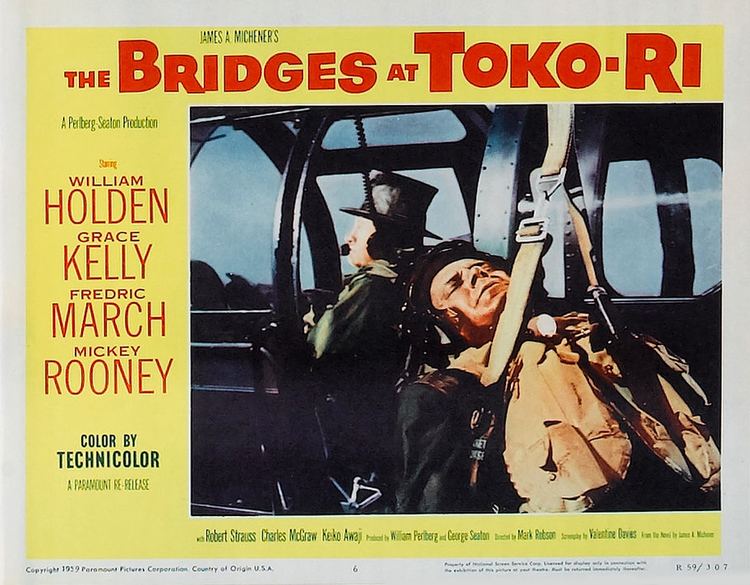
The screenplay is based on the novel The Bridges at Toko-Ri by Pulitzer Prize winner James Michener. The story, which closely follows the novel, is about the U.S. Navy pilots assigned to bomb a group of heavily defended bridges in North Korea. It emphasizes the lives of the pilots and crew in the context of the Korean War; a conflict that seems remote to all except those who fight in Korea.
the bridges at toko ri after hitting the second target
Plot

U.S. Navy Lieutenant Harry Brubaker (William Holden) is a Naval Reserve officer and Naval Aviator who was called back to active duty from his civilian profession as an attorney to fly fighter-bombers in the Korean War. Returning from a mission with battle damage, he is forced to ditch into the sea and is rescued by a Sikorsky HO3S-1 helicopter manned by Chief Petty Officer (NAP) Mike Forney (Mickey Rooney) and Airman (NAC) Nestor Gamidge (Earl Holliman).
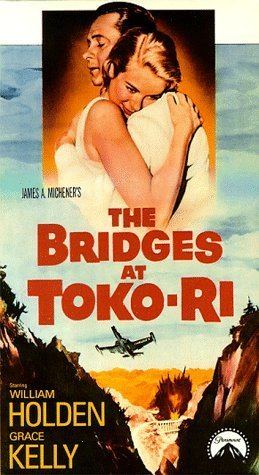
Forney had often been in trouble for brawling and sporting a non-regulation green top hat and scarf while flying his helicopter as encouragement to downed pilots in the water. Back aboard his ship, the aircraft carrier USS Savo Island, Brubaker is called to the quarters of Rear Admiral Tarrant (Fredric March), the Carrier Task Force 77 commander, who has taken an interest in Brubaker because he reminds Tarrant of his son, a Navy Pilot killed in World War II. Brubaker complains about the unfairness of his recall when most actively flying/actively drilling Naval Reserve pilots weren't recalled (Brubaker hadn't been flying in the Reserve), America is not actually "at war", and most Americans have no involvement. Tarrant advises that, "All through history, men have had to fight the wrong war in the wrong place, but that's the one they're stuck with."
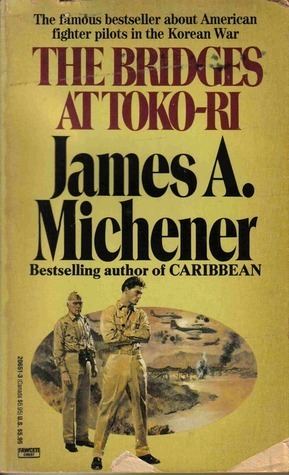
The Savo Island returns to port in Japan, where Brubaker is given a three-day shore leave in Tokyo with his wife Nancy (Grace Kelly) and their children. The reunion is interrupted when Gamidge comes to Brubaker asking his help in bailing Forney out of the brig after a brawl. Nancy expresses her bewilderment to Tarrant, who explains that Forney saved her husband from freezing to death when he had to ditch his jet at sea and warns her that when they return to Korea, Brubaker will have to attack the dangerous bridges at Toko-Ri. He advises her to face the reality that Harry might be killed, which neither his wife nor daughter-in-law did, and thus were crushed by despair. Late that night Nancy asks Brubaker about the bridges.
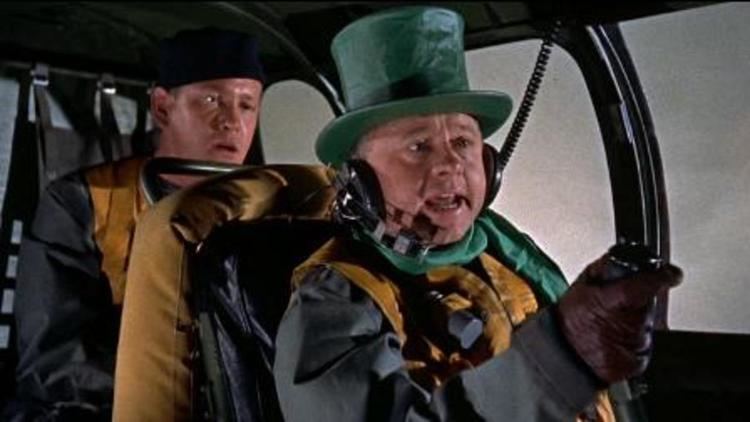
Back on a carrier off Korea, Brubaker flies as wingman for Commander Lee (Charles McGraw), the carrier air group commander known as "CAG," on a dangerous reconnaissance to photograph the bridges. Lee briefs his pilots on the coming mission using the film he took and Brubaker loses his nerve. However, he cannot bring himself to quit the mission or write a final letter to Nancy. Forney crosses the Captain of the Savo Island once too often, and then he is exiled to a helicopter scow. As he is leaving the ship, he notices Brubaker's distress, and relates a "cure" for bad nerves that has worked for him. Brubaker follows his advice and finds renewed strength within himself.
In the attack on the bridges, the antiaircraft fire is intense, but the jets destroy the bridges without a loss. Lee then leads them to attack a secondary target, where Brubaker’s jet is hit. Leaking fuel and descending, he tries to return to the carrier, but he cannot and crash-lands on land. Forney and Gamidge attempt to pick him up, but communist troops shoot down the helicopter. Gamidge is killed, and Forney takes cover in a muddy ditch with Brubaker. They try to hold off the enemy with pistols and Forney's and Gamidge's M1 carbines until they can be rescued, but both are killed by the North Korean and Red Chinese soldiers. Tarrant, angered by the news of Brubacker's death, demands an explanation from Commander Lee of why he attacked the second target. Lee defends his actions, noting that Brubaker was his pilot too, and that despite his loss, the mission was a success. Tarrant, realizing that Lee is correct, rhetorically asks, "Where do we get such men?"
Writing
Michener based his novel on actual missions flown against the railroad bridges at Majon-ni and Samdong-ni, North Korea, during the winter of 1951–52, when he was a news correspondent aboard the aircraft carriers USS Essex and USS Oriskany. Michener based the character of Harry Brubaker on Lieutenant Donald S. Brubaker, who like his counterpart, was a 29-year-old Naval Reservist from Denver recalled to active duty aboard the Valley Forge. The basis for Admiral Tarrant was Rear Admiral John Perry, the carrier division commander at the time; that of Lee was Commander Marshall U. Beebe, CAG aboard the Essex in 1951 and technical advisor for the film; and Forney on Chief (NAP) Duane Thorin, himself a colorful enlisted pilot known for his trademark non-regulation green headgear.
The pilot's rescue attempt at the climax of the novel and film was a composite of a pair of unrelated rescue attempts on February 8, 1952, both in the area of Wonsan, North Korea, with the second one involving a propeller-driven Douglas AD-1 Skyraider from the Valley Forge that had been shot down while bombing the railroad bridges at Samdong-ni. However, though the shot-down aviators in the second attempt were initially listed as missing in action, they survived their ordeal, and they were captured by North Korean soldiers.
In the attacks against the historical bridges, the McDonnell F2H Banshee fighter-bombers (represented by Grumman F9F Panther) that are at the heart of the story did not bomb the bridges themselves, since they did not have the capability of carrying the heavy aerial bombs that were needed. Instead, they carried out the perilous mission of suppressing enemy anti-aircraft fire.
Filming
Exteriors were shot aboard the USS Oriskany (CV-34) and the USS Kearsarge (CV-33), 27,100-ton Essex-class aircraft carriers standing in for the USS Savo Island. The aircraft used in the film is the Grumman F9F-2 Panther, a Korean War workhorse still in service and equipping the air groups of both carriers, at the time the film was made. In the novel, however, Brubaker's squadron flew McDonnell F2H Banshees. The squadron depicted is an actual unit, Fighter Squadron 192 (VF-192) "Golden Dragons," which was aboard the Oriskany during the filming, and from its part in the movie, thereafter, billed itself as the "World Famous Golden Dragons." VF-192 had two war deployments to Korea, but aboard the USS Princeton (CV-37) and flying Vought F4U-4 Corsairs. The squadron continues service today as Strike Fighter Squadron 192 (VFA-192), a McDonnell Douglas F/A-18 Hornet unit.
Location filming was also done in Japan at Yokosuka, Kanagawa and the historic Fujiya Hotel at Hakone.
Reception
The Bridges at Toko-Ri was well received by critics and public alike. As an example of the films that came out of the Korean War, it was considered more of a multi-faceted account that dealt with both ordinary seamen and command officers involved in combat. Typical of the reviews was one by Bosley Crowther of The New York Times, who noted how the film adaptation was true to the original story and was "vividly and movingly developed in this punctilious film." The close cooperation of the U.S. Navy led to spectacular aerial scenes as well as carrier action. A raid sequence with large scale models intercut with combat footage was a particularly effective scene that was later recognized in the Academy Awards.
Awards and honors
The Bridges at Toko-Ri won the Academy Award for Best Special Effects (1956) and Alma Macrorie was nominated for an Academy Award for Best Editing (1956). Mark Robson was also nominated for Outstanding Directorial Achievement in Motion Pictures in the Directors Guild of America Awards (1956).
The film is recognized by American Film Institute in these lists:
